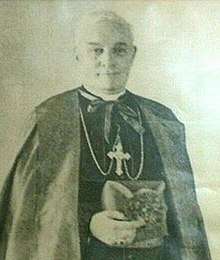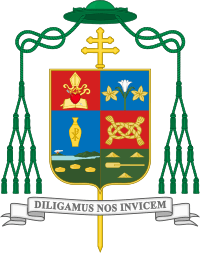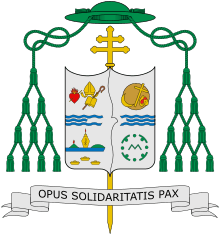Roman Catholic Archdiocese of Cagayan de Oro
The Archdiocese of Cagayan de Oro (Latin: Archidioecesis Cagayana) is an archdiocese of the Roman Catholic Church in the Philippines. It is a metropolitan see on the island of Mindanao which comprises the civil provinces of Misamis Oriental, Camiguin and the municipality of Malitbog, Bukidnon. Its seat is located at Saint Augustine Metropolitan Cathedral[1] in Cagayan de Oro City.
Archdiocese of Cagayan de Oro Archidioecesis Cagayana Arkidyosesis sa Cagayan de Oro Arquidiócesis de Cagayán de Oro | |
|---|---|
 Saint Augustine Metropolitan Cathedral, Seat of the Archdiocese of Cagayan de Oro | |
 | |
| Location | |
| Country | |
| Territory | Cagayan de Oro City, Misamis Oriental, Camiguin, and Malitbog, Bukidnon |
| Ecclesiastical province | Cagayan de Oro |
| Deaneries | 6 |
| Statistics | |
| Area | 3,799 km2 (1,467 sq mi) |
| Population - Total - Catholics | (as of 2016) 1,435,098 1,075,773 (75.0%) |
| Parishes | 62 |
| Information | |
| Denomination | Roman Catholic |
| Sui iuris church | Latin Church |
| Rite | Roman Rite |
| Established | January 20, 1933 (as diocese) June 29, 1951 (as archdiocese) |
| Cathedral | Saint Augustine Metropolitan Cathedral |
| Patron saint | St. Augustine of Hippo |
| Secular priests | 109 |
| Current leadership | |
| Pope | Francis |
| Metropolitan Archbishop | José Araneta Cabantan, elect |
| Suffragans | Diocese of Surigao Diocese of Butuan Diocese of Malaybalay Diocese of Tandag |
| Apostolic Administrator | Antonio Ledesma, SJ |
| Vicar General | Fr. Perseus P. Cabunoc Msgr. Rey Monsanto |
| Bishops emeritus | Antonio Ledesma, SJ |
| Map | |
 Jurisdiction of the metropolitan see within the Philippines. | |
| Website | |
| Official website | |
History
During the Spanish era only the Province of Misamis existed, which included the present Provinces of Misamis Oriental and Misamis Occidental, and was handled by the civil government from Cebu. The Recollect Missionaries arrived from Cebu and started a mission in the province. A civil government of its own started only in 1901, and because one part of it was separated from the main by Iligan Bay, the government decided to divide the province into two. Misamis Oriental is the bigger portion. Today the Diocesan Cathedral is one of the 12 Cathedrals that was founded by the Order of Augustinian Recollects in the Philippines.
Before 1865, the whole of Mindanao island and Sulu were part of the Diocese of Cebu. In 1865 the western half of Mindanao came under the jurisdiction of the Diocese of Jaro in Panay. Then Pope Leo XIII established the Diocese of Zamboanga, separating it from Jaro and making it the first diocese in Mindanao. But it was Pope Pius X who executed this in 1910. Thus from 1910 Cagayan de Oro City became part of the Diocese of Zamboanga.
It was only after forty-five years, in 1910, that the diocese of Zamboanga was established as the first diocese ever created in the entire island. Then, twenty-five years after in 1933, Pope Pius XI in a Papal Bull entitled “Ad maius religionis” divided Mindanao between the diocese of Zamboanga in the south and a new diocese that of Cagayan de Oro in the north, to which he appointed an American Jesuit, James Hayes, as the first bishop.
The original territory of the diocese of Cagayan de Oro in 1933 included the provinces of Surigao, Agusan, Bukidnon, Misamis Oriental, Misamis Occidental, Lanao and the island of Camiguin. A series of divisions however, gradually reduced this territory.
During the episcopacy of Bishop Hayes, in 1933, he founded two secondary schools, later raised to colleges – Lourdes College for Girls (run by the RVM Sisters) and the Ateneo de Cagayan for Boys (run by the Jesuits and raised to University status as Xavier University in 1958).
It was in the thirteenth year of the Pontificate of Pope Pius XII, on the 29th of June 1951, when the Papal Bull, Quo Phillipina Republica, was decreed in order to serve better and more easily the spiritual needs of the Lord’s flock in the Philippine Republic. The bull contained the Pope’s decision to create new Dioceses and to constitute new Ecclesiastical Provinces in the Philippines. The Dioceses of Lingayen, Caceres, Nueva Segovia, Tuguegarao, Legaspi, Sorsogon, and the Prelature Nullius of Batanes and Babuyanes, as well as the Dioceses Bacolod, Cagayan, Capiz, Jaro or Santa Isabel, Surigao, Zamboanga, and the Prelature Nullius of Cotabato and Sulu, Davao and Ozamis, were withdrawn from the Metropolitan Archbishoprics of Manila and Cebu. From these Dioceses, four new Ecclesiastical Provinces were constituted, namely, Nueva Segovia, Caceres, Jaro, and Cagayan de Oro. The Episcopal seats of these dioceses were elevated to the rank and dignity of Metropolitan Archbishops. Bishop James G. Hayes, S.J., became the Metropolitan Archbishop. Later, the Apostolic Prefecture of Sulu, the Prelature Nullius of Marbel, the Prelature Nullius of Tagum, the Diocese of Butuan, the Prelature Nullius of Malaybalay, the Prelature Nullius of Iligan and the Diocese of Tandag became suffragans of the Archdiocese of Cagayan de Oro.
Eventually four other archdioceses were established in Mindanao island: Zamboanga in 1958, Davao in 1970, Cotabato in 1979 and Ozamiz in 1983. Thus there are at present five ecclesiastical provinces in Mindanao.
In 1952, the first Columban missionaries arrived in Cagayan de Oro as a response to the Archbishop’s invitation because he felt the dearth of priests who would care for his flock. In 1956, in order to respond to the growing number of priests in the diocese, the San Jose de Mindanao Seminary was opened with Fr. Theodore A. Daigler, SJ, as its first rector. In 1958, the Maria Reyna Hospital was opened and directed by the Sisters of St. Paul of Chartres.
After long years of service to the people of Cagayan de Oro and with so much effort to put up the foundations of the Archdiocese since his arrival in 1926, Archbishop Hayes, the modest and humble shepherd of Cagayan de Oro for almost half a century, retired in 1971.
On January 12, 1971, Patrick Cronin,an Irish Columban Missionary, formerly Prelate Ordinary of Ozamis and Iligan was installed as Archbishop of the Ecclesiastical Province of Cagayan de Oro replacing Archbishop Hayes who had just retired. He continued what Archbishop Hayes had begun. In 1976, through the initiatives of the Archbishop, the House of Friendship located amidst the slum areas of Sto. Nino, Cagayan de Oro City, was opened in order to cater to the needs of the orphans, neglected children, aged, unwed mothers, physically handicapped, refugees, stranded persons, transient indigents, and victims of calamities. At the age of 74 and after serving the people of Cagayan de Oro with utmost love and care, Archbishop Cronin retired due to old age and settled at St. Patrick’s House, Seminary Hill, which he intentionally built as a retirement home and at the same time a home for the aged, sick, and incapacitated diocesan priests of the Archdiocese. To date, priests get together on Mondays for games, meetings, and prayers at St. Patrick’s House.
The Holy Father, Pope John Paul II, accepted his resignation as Archbishop of the Ecclesiastical Province of Cagayan de Oro. The resignation took effect on January 5, 1988. Jesus B. Tuquib, a native from Clarin, Bohol, who had been the Coadjutor Archbishop took over the office and functions of Archbishop Cronin on that day until the year 2006. On the 30th day of May 2006 Antonio J. Ledesma was installed as the fourth Archbishop of Cagayan de Oro. Previously, he was Bishop of the Prelature of Ipil in southwestern Mindanao from 1996 to 2006.
There are 46 diocesan priests manning the 46 parishes within the jurisdiction of the archdiocese, helped by two Jesuit and five Columban priests. Six others are doing non-parochial work and 3 others are in retirement. The rest of the Jesuits are in Xavier University – Ateneo de Cagayan or in the major seminary, and the rest of the Columbans, apart from the five involved in parish work, are in their procure house doing various apostolates such as hospital work and other activities. There are 18 religious institutes of women, one of which is a contemplative institute, the Carmelite nuns.
The archdiocese has its own diocesan college seminary, the San Jose de Mindanao Seminary that opened in 1955. It was constructed by Archbishop Hayes, was first administered by the Jesuits, then by Columban priests, and now by the diocesan clergy.
Also within the archdiocese is a theology seminary - the St. John Vianney Theological Seminary, which is mainly for seminarians of the Ecclesiastical Metro Cagayan de Oro. This was started by Archbishop Cronin and finished by Archbishop Tuquib. It opened in 1985.
Suffragan dioceses
Ordinaries
| Archbishop | Period in Office | ||
|---|---|---|---|
| 1. |  | James Hayes, S.J. | 1951–1970 |
| 2. | Patrick Cronin, S.S.C. | 1970–1988 | |
| 3. |  | Jesus Tuquib | 1988–2006 |
| 4. |  | Antonio Ledesma, S.J. | 2006–2020 |
| 5. |  | José Cabantan | Appointed 23 June 2020 |
See also
- Cagayan de Oro City
- Roman Catholicism in the Philippines
References
- "Parishes and Parochial Clergy". Catholic Bishops Conference of the Philippines.